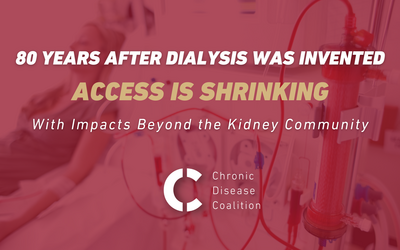
Dialysis is a health care innovation that was first invented back in 1943. While we celebrate 80 years of lives saved, our country is facing more kidney disease than ever, and we are still fighting for access to this essential treatment.
Despite widespread awareness of sharp increases to the costs of both equipment and skilled healthcare workers, the Center for Medicare and Medicaid Services (CMS) recently proposed a shockingly low 2024 reimbursement increase of 1.7% for dialysis treatment.
For context, the 2023 increase was 3.1% - which was still inadequate to keeping up with the cost of care. U.S. Department of Labor statistics estimate that the cost of labor alone increased more than 8% in recent years.
This latest proposal compounds the challenges that many dialysis providers are facing across the country, especially in rural areas where care can be more difficult for patients to access. The 1.7% increase amounts to about $4.42 additional per treatment, or $269.99, according to our partners at the Renal Support Network.
That amount is supposed to cover all the aspects of one dialysis treatment. That includes supplies, facility space, property insurance, pay for the entire care team (nephrologists, nurses, technicians, social workers, dietitians, and others), injectable and oral drugs, lab tests, home dialysis training, and ongoing patient monitoring.
The inadequacy of the pay rate is not a new problem – but it has directly led to the closure of hundreds of dialysis facilities across the country this year. Shortfalls in CMS reimbursement rates are also impacting patients with other common chronic conditions, including psoriasis, arthritis, and diabetes.
This is not just a kidney disease problem, but it is felt acutely in dialysis clinics, where the care is extensive and patients have few other options. When Medicare and Medicaid don’t reimburse the total cost of care, it puts pressure on staff salaries that can make it impossible to retain and recruit high quality caregivers.
Staff shortfalls can ultimately lead to clinic closures, and once a clinic closes, it’s rare that they come back. Patients are forced to travel great distances – at even greater personal expense – to receive lifesaving treatment. Those reliant on public transportation for travel to dialysis must find alternate options when the closest treatment option has become a longer distance and public transport is not available.
Staff shortfalls can ultimately lead to clinic closures, and once a clinic closes, it’s rare that they come back. Patients are forced to travel great distances – at even greater personal expense – to receive lifesaving treatment.
The Chronic Disease Coalition is working hard to reverse this trend, so that the next 80 years of dialysis are years of success and not failure. We know that many of our partners in the kidney community are active, including Renal Support Network, Dialysis Patient Citizen, National Kidney Foundation and the Northwest Kidney Council – but we urge all patient advocacy groups to continue to monitor this situation carefully. The ramifications of inadequate reimbursement rates hurt all patients and providers.
CMS is accepting public comment on the 2023 proposed pay rule through Aug. 25. Join us and stand up for a better health care system that prioritizes chronic patients.